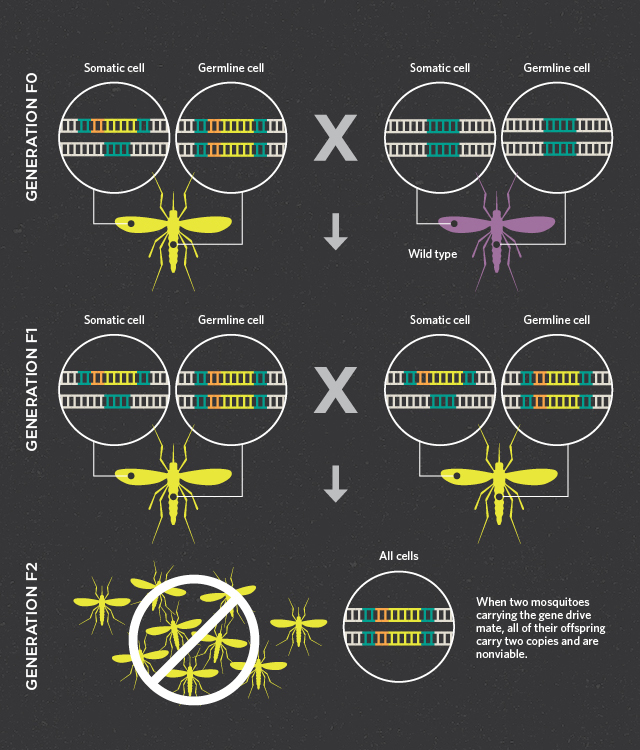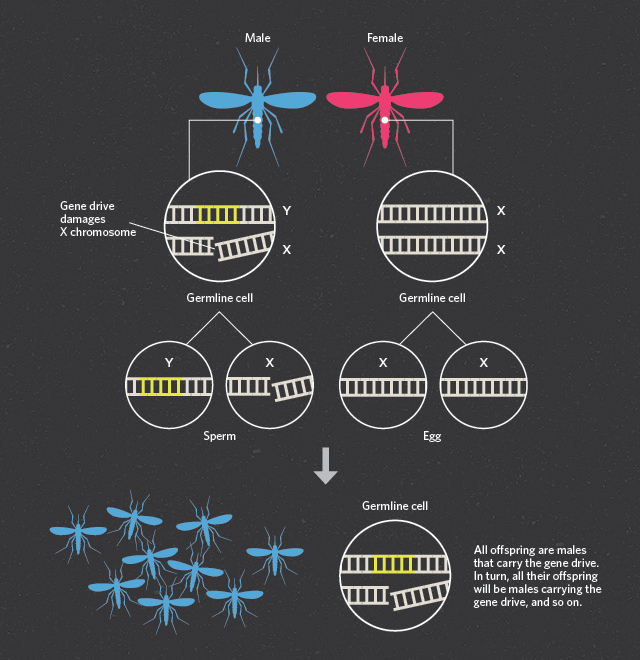While introducing genetic changes has long been supported by advancing technologies, getting those modifications to spread through wild mosquito populations has remained a challenge. Now, the newly understood concept of gene drive, in which genetic elements can spread more rapidly than those following traditional Mendelian inheritance principles, may finally solve the problem.
HOW GENE DRIVE WORKS
 HOW GENE DRIVES SPREAD
HOW GENE DRIVES SPREAD
Without gene drive, an allele will be passed from generation to generation via traditional Mendelian genetics. That is, when a heterozygous individual carrying only one copy of the allele mates with an individual lacking it altogether, only half of their offspring will inherit the genetic segment. But in a gene drive that spreads the allele to the homologous chromosome in the germline, all progeny will receive a copy. With gene drive, it’s even possible for a deleterious allele to spread through the population, despite imposing a severe fitness cost....
HOW GENE DRIVE COULD BE USED TO CONTROL MALARIA
There are three general approaches to implementing gene drives in mosquito populations for the control of malaria: (1) spread a deleterious mutation to reduce mosquito numbers, (2) distort the sex ratio of the population, or (3) deliver cargo to render mosquitoes resistant to the malaria parasite.
 (1) POPULATION-WIDE GENE KNOCKOUT
(1) POPULATION-WIDE GENE KNOCKOUT
 A gene drive can be designed to disrupt a mosquito gene essential for survival or reproduction. In this case, researchers would restrict its expression to the germline, such that individuals that have one copy of the inserted genetic element aka gene drive) still have a functioning copy of the mosquito gene in the rest of their body where it is needed and therefore act as carriers of the gene drive. In the germline, however, the gene drive spreads, increasing the proportion of gametes that carry it. When released into the wild, these animals would mate and pass on the gene drive to all offspring. When two mosquitoes carrying the gene drive mate, none of their offspring would inherit a functional copy of the essential gene, decimating the population.
A gene drive can be designed to disrupt a mosquito gene essential for survival or reproduction. In this case, researchers would restrict its expression to the germline, such that individuals that have one copy of the inserted genetic element aka gene drive) still have a functioning copy of the mosquito gene in the rest of their body where it is needed and therefore act as carriers of the gene drive. In the germline, however, the gene drive spreads, increasing the proportion of gametes that carry it. When released into the wild, these animals would mate and pass on the gene drive to all offspring. When two mosquitoes carrying the gene drive mate, none of their offspring would inherit a functional copy of the essential gene, decimating the population.
(2) SKEWED SEX RATIO
A gene drive designed to selectively destroy the X chromosome in Anopheles gambiae sperm will result in the nonviability of those sperm, leaving only sperm carrying Y chromosomes. This will lead to a sex ratio greatly skewed toward males, which will eventually cause the population to crash.

(3) POPULATION-WIDE GENE KNOCK-IN
A gene drive can also be designed to deliver a cargo, such as an antimicrobial peptide, that makes mosquitoes resistant to the malaria parasite. In this case, the antimalarial cargo would be expressed wherever the parasite is most vulnerable, whereas germline expression of the gene drive would guarantee its spread through the population.

Read the full story.
Interested in reading more?




